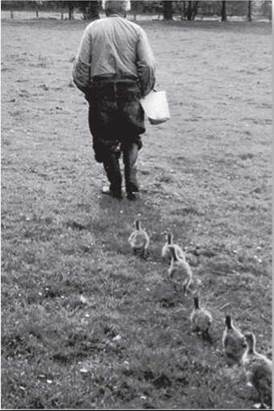THE LIVING WORLD
Unit Eight. The Living Environment
37. Behavior and the Environment
Many of the behavioral patterns displayed by animals are not the result solely of instinct. In many cases, animals alter their behavior as a result of previous experiences, a process termed learning. The simplest type of learning, nonassociative learning, does not require an animal to form an association between two stimuli, or between a stimulus and a response. One form of nonassociative learning is sensitization, in which repeating a stimulus produces a greater response. Another form of nonassociative learning is habituation, a decrease in response to a repeated stimulus. In many cases, the stimulus evokes a strong response when it is first encountered, but the magnitude of the response gradually declines with repeated exposure. As an everyday example, are you still conscious of the chair you are sitting in? Habituation can be thought of as learning not to respond to a stimulus. Being able to ignore unimportant stimuli is critical when facing a barrage of stimuli in a complex environment.
A change in behavior that involves an association between two stimuli, or between a stimulus and a response, is called associative learning. The behavior is modified, or conditioned, through the association. This form of learning is more complex than habituation. The two major types of associative learning are called classical conditioning and operant conditioning. They differ in the way the association is established.
Classical Conditioning
In classical conditioning, the paired presentation of two kinds of stimuli causes the animal to form an association between the stimuli. When the Russian psychologist Ivan Pavlov presented meat powder, an unconditioned stimulus, to a dog, the dog responded by salivating. If an unrelated stimulus, such as the ringing of a bell, was present at the same time as the meat powder, then over repeated trials the dog would come to salivate in response to the sound of the bell alone. The dog had learned to associate the unrelated sound stimulus with the meat powder stimulus. Its response to the sound stimulus had become conditioned; the sound of the bell was now a conditioned stimulus.
Operant Conditioning
In operant conditioning, an animal learns to associate its behavioral response with a reward or punishment. Psychologist B. F. Skinner studied operant conditioning in rats by placing them in an experimental cage nicknamed a “Skinner box.” As the rat explored the box, it would occasionally press a lever by accident, causing a pellet of food to appear. At first, the rat would ignore the lever, eat the food pellet, and continue to move about. Soon, however, it would learn to associate pressing the lever (the behavioral response) with food (the reward). When a conditioned rat was hungry, it would spend all its time pressing the lever. This sort of trial-and-error learning is of major importance to most vertebrates.
Imprinting
As an animal matures, it may form preferences or social attachments to other individuals that will profoundly influence behavior later in life. This process, called imprinting, is sometimes considered a type of learning. In filial imprinting, social attachments form between parents and offspring. For example, young birds of some species begin to follow their mother within a few hours after hatching, forming a strong bond between mother and young. This is a form of associative learning—it is the association the young bird forms during a critical window of time (roughly 13 to 16 hours in geese, for example) that determines how the imprint will be established. Birds will follow the first object they see after hatching, and direct their social behavior toward that object as their mother. Ethologist Konrad Lorenz raised geese from eggs, and when he offered himself as a model for imprinting, the goslings treated him as if he were their parent, following him dutifully (figure 37.4).

Figure 37.4. An unlikely parent.
The eager goslings follow ethologist Konrad Lorenz as if he were their mother. He is the first object they saw when they hatched, and they used him as a model for imprinting.
Key Learning Outcome 37.4. Habituation and sensitization are simple forms of learning in which there is no association between stimulus and response. In contrast, associative learning (conditioning and imprinting) involves the formation of an association between two stimuli or between a stimulus and a response.